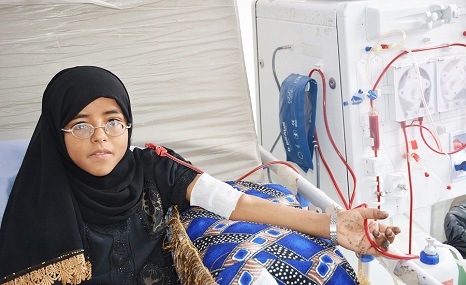
Seham’s struggles
by the World Health Organization
Seham was just six years old when she was first diagnosed with chronic kidney disease.
Together with her parents, she traveled hundreds of kilometers in search of diagnosis and treatment, from her home in Razeh District in Sa’ada governorate in Yemen’s north, to Hajjah and Sana’a in the country’s west.
“She was in a coma when she started her first dialysis session in Sana’a” said Seham’s mother, Um-Seham. “We couldn’t afford the cost of living in Sana’a so we decided to return to Sa’ada. We had to move from our village to Sa’ada City, renting a one room apartment near the hospital.”
Now 10 years old, it is not only the kidney pain and gradual loss of vision that make Seham’s life challenging.
“Because of this disease, I had to stop going to school,” said Seham. “All I want is to be free from this disease and to go back again to my studies.”
Accessing dialysis has always been tricky in Yemen, the poorest country in the Middle East. But the conflict has created additional challenges, with health facilities facing a shortage of dialysis supplies and travel complicated by checkpoints and insecurity. In the midst of an economic crisis, many patients complain that they can barely afford the cost of transportation to and from the health centers for the multiple treatment sessions they need each week.
Seham is one of more than 5,000 kidney patients in Yemen who struggle to access regular dialysis sessions. Treatment for non-communicable diseases in general –- a category which includes illnesses such as kidney disease, diabetes, high blood pressure, and cancer –- are available in few health facilities (about 20 percent).
Ongoing conflict, high levels of poverty and the collapsing health system have left thousands struggling for access to the care they need to stay alive. Non-communicable diseases are now killing more people than bullets or bombs, accounting for 39 percent of all mortality in Yemen.
Seham is one of the luckier ones. This week, the World Health Organization (WHO) transported 100 tonnes of supplies provided through a private-public partnership between Yemen and Germany to the dialysis center she regularly attends at Al-Jumhoori Hospital in Sa’ada.
But the need for dialysis supplies remains high across Yemen. In some parts of the country, dialysis sessions have been reduced from three sessions per week to one session or less due to a lack of supplies. When there are not enough supplies in the hospitals, patients are required to purchase their own dialysis set (filters, tubes etc) for around $40 per session -– a cost that is impossibly high for many patients.
WHO and partners are supporting the local health authorities to provide health services across Yemen, including care for non-communicable diseases.
The Organization is calling on parties to the conflict and their allies to facilitate the safe and unimpeded passage of life-saving medicines and supplies to people in need across Yemen.
~ ~ ~
These announcements are interactive. Click on them for more information.










